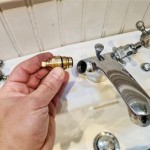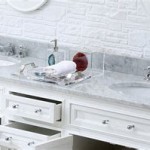How to Clean Bathroom Mould
Bathroom mould is a common household problem, flourishing in the warm, humid environment created by showers, baths, and poor ventilation. Addressing mould growth promptly is crucial not only for aesthetic reasons but also for preventing potential health issues, including allergic reactions, respiratory problems, and skin irritation. Effective mould removal requires understanding the types of mould common in bathrooms, employing appropriate cleaning solutions, and implementing preventative measures to minimize future growth. This article details a comprehensive approach to cleaning bathroom mould, covering identification, preparation, cleaning techniques, and prevention strategies.
Identifying Bathroom Mould
Before attempting to clean bathroom mould, accurately identifying the type of growth is beneficial. While distinguishing between mould species generally necessitates professional testing, basic visual and olfactory cues can provide clues. Common types of mould found in bathrooms include:
Black Mould (Stachybotrys Chartarum): Often appearing as a dark green or black slimy substance, black mould is associated with severe health risks due to the production of mycotoxins. Although not all black-colored mould is Stachybotrys, any dark, suspect growth should be approached with caution.
Aspergillus: This mould exhibits a range of colors, including green, yellow, and brown. It is a common allergen and can cause respiratory problems, particularly in individuals with weakened immune systems.
Cladosporium: Typically dark green or black, Cladosporium can grow in both warm and cool environments. It is commonly found on painted surfaces and fabrics and can trigger allergic reactions.
Alternaria: Characterized by its dark brown or black appearance, Alternaria thrives in damp environments, such as showers and window sills. It is a common cause of allergic rhinitis and asthma.
The presence of a musty or earthy odor often indicates mould growth, even when visible signs are not immediately apparent. Inspect areas prone to moisture accumulation, such as grout lines, shower corners, behind toilets, and under sinks, for signs of discoloration or growth.
Preparing for Mould Removal
Safety is paramount when cleaning bathroom mould. Mould spores can become airborne during the cleaning process and can be inhaled, potentially causing respiratory irritation or allergic reactions. The following safety precautions are essential:
Personal Protective Equipment (PPE): Wear appropriate PPE to minimize exposure to mould spores. This includes:
Respirator: An N-95 respirator or a higher-rated mask will filter out mould spores and prevent inhalation. Gloves: Non-porous gloves, such as rubber or nitrile gloves, will protect skin from direct contact with mould and cleaning solutions.
Eye Protection: Goggles or safety glasses will prevent mould spores and cleaning agents from entering the eyes.
Ventilation: Ensure adequate ventilation in the bathroom by opening windows and using an exhaust fan. This will help remove airborne mould spores and reduce humidity levels.
Containment: If dealing with a significant mould infestation, consider containing the affected area to prevent the spread of spores to other parts of the house. This can be achieved by sealing doorways with plastic sheeting and tape.
Gather Cleaning Supplies: The effectiveness of mould removal depends on using appropriate cleaning solutions and tools. The following supplies are recommended:
Mould-Killing Cleaner: Choose a cleaner specifically designed to kill mould and mildew. Options include:
Bleach Solution: A solution of one part bleach to ten parts water is effective for killing surface mould. However, bleach can damage certain materials and should not be mixed with ammonia or other cleaners.
Hydrogen Peroxide: A 3% hydrogen peroxide solution is a gentler alternative to bleach and is effective for killing mould on porous surfaces.
Vinegar: White vinegar is a natural disinfectant and can kill mould effectively. It is safe for use on most surfaces.
Baking Soda: Baking soda is a mild abrasive that can help scrub away mould and is also an effective deodorizer.
Cleaning Tools: The following tools will aid in the cleaning process:
Scrub Brush: A stiff-bristled scrub brush is ideal for removing mould from grout lines and other textured surfaces.
Spray Bottle: A spray bottle is useful for applying cleaning solutions to affected areas.
Sponge: A sponge can be used to wipe down smooth surfaces after cleaning.
Old Rags or Paper Towels: These are essential for wiping away mould and cleaning solutions.
Scraper: A plastic scraper can be used to remove stubborn mould from surfaces without causing damage.
Effective Mould Cleaning Techniques
The specific cleaning technique will vary depending on the type of surface affected by mould. The following guidelines outline effective cleaning methods for common bathroom surfaces:
Grout: Grout lines are particularly susceptible to mould growth due to their porous nature. To clean mould from grout:
Apply Cleaning Solution: Spray the affected grout lines with the chosen cleaning solution (bleach solution, hydrogen peroxide, or vinegar). Ensure the grout is thoroughly saturated.
Scrub: Use a stiff-bristled scrub brush to vigorously scrub the grout lines. Apply firm pressure to remove mould and stains.
Rinse: Rinse the grout lines with clean water to remove any remaining cleaning solution and loosened mould.
Dry: Thoroughly dry the grout lines with a clean cloth or paper towels. Excess moisture can promote further mould growth.
Caulk: Caulk around showers, bathtubs, and sinks is also prone to mould growth. If the mould is deeply embedded in the caulk, it may be necessary to remove and replace the caulk. To clean surface mould from caulk:
Apply Cleaning Solution: Apply the chosen cleaning solution to the affected caulk.
Let it Sit: Allow the cleaning solution to sit on the caulk for several minutes to allow it to penetrate the mould.
Scrub: Gently scrub the caulk with a scrub brush or sponge.
Rinse: Rinse the caulk with clean water.
Dry: Dry the caulk thoroughly.
Walls and Ceilings: Mould can also grow on painted walls and ceilings, particularly in areas with poor ventilation. To clean mould from these surfaces:
Apply Cleaning Solution: Apply the chosen cleaning solution to the affected area using a spray bottle or sponge. Avoid oversaturating the surface, as this can damage the paint.
Wipe: Gently wipe the surface with a sponge or cloth to remove mould.
Rinse: Rinse the surface with a clean, damp cloth.
Dry: Dry the surface thoroughly.
Shower Curtains: Plastic shower curtains are susceptible to mould growth due to constant exposure to moisture. To clean a shower curtain:
Machine Washing: If the shower curtain is machine washable, wash it in warm water with detergent and a cup of bleach. Hang the curtain to dry.
Hand Washing: If the shower curtain is not machine washable, hand wash it with a cleaning solution of bleach and water. Rinse thoroughly and hang to dry.
For fabric shower curtains, washing them regularly is crucial in preventing mould. Consider using a water-repellant spray to further protect the fabric.
Preventing Future Mould Growth
Once mould has been successfully removed, implementing preventive measures is essential to minimize the risk of future growth. The following strategies are recommended:
Improve Ventilation: Proper ventilation is crucial for reducing humidity levels in the bathroom. Ensure the exhaust fan is working correctly and use it during and after showers and baths. Open windows to allow fresh air to circulate.
Reduce Humidity: Minimize humidity levels in the bathroom by:
Drying Surfaces: Wipe down wet surfaces, such as shower walls and floors, after each use. Use a squeegee to remove excess water.
Fixing Leaks: Repair any leaks promptly, as they can contribute to moisture accumulation and mould growth.
Using a Dehumidifier: Consider using a dehumidifier in the bathroom to further reduce humidity levels, especially in poorly ventilated spaces.
Regular Cleaning: Clean the bathroom regularly to prevent the buildup of soap scum, dirt, and other organic matter that can serve as a food source for mould.
Use Mould-Resistant Products: When renovating or remodeling the bathroom, consider using mould-resistant building materials, such as mould-resistant drywall and grout.
Proper Air Circulation: Ensure air can circulate freely throughout the bathroom by avoiding overcrowding the space with unnecessary items.
By consistently implementing these preventative measures, the likelihood of future mould growth in the bathroom can be significantly reduced, maintaining a healthier and more hygienic environment.

How To Clean A Mouldy Shower Like Pro

How To Clean Mold In Shower Grout Tips And Tricks Certified Care

How To Clean Bathroom Mould Sanctuary Bathrooms

How To Clean A Moldy Shower Super Satisfying With Me

How To Kill Bathroom Mould Without Bleach Electrodry Blogs

Black Mold In The Shower How To Clean It Kitchen With Matt

Remove Mould From Bathroom Tiles With 1 Natural Item Not Vinegar Or Bicarb News Express Co

How To Clean Mold In Tile Grout Jdog Carpet Cleaning Floor Care

How To Remove Bathroom Mold On Showers Ceilings More

How To Prevent Mould On The Bathroom Ceiling Dbs Bathrooms
Related Posts







